|
Whitman
Rocks Tibet by Bob Carson
June
1: Arrival on the Roof of the World (Chengdu-Lhasa)
Having
left Walla Walla on Saturday, 28 May, Clare and I finally landed in
Tibet at the Gongkar airport between the capital Lhasa and the third
largest city, Tsetang. With us are 18 Whitman students (4 now alums),
12 women and 6 men, of 9 different majors. We hooked up with them in
Seattle, Nerita (near Tokyo, Japan), and Bangkok. Each of the 4 flights
was, fortunately, shorter than the previous one.
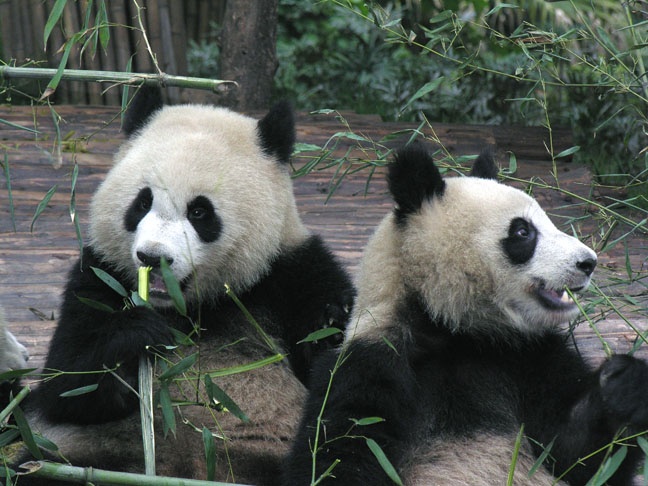 We all overnighted in Bangkok, Thailand, and Chengdu, western China.
The only significant event between Washington and Tibet was visiting
giant and red pandas in Chengdu. Through the clouds below our last flight
we glimpsed the snowy Himalayan peaks.
We all overnighted in Bangkok, Thailand, and Chengdu, western China.
The only significant event between Washington and Tibet was visiting
giant and red pandas in Chengdu. Through the clouds below our last flight
we glimpsed the snowy Himalayan peaks.
At the airport we were greeted by Palden and Lhada, two of our three
guides. They placed a white prayer scarf around each of our necks. Palden,
our lead guide, is from Bhutan and speaks many languages; Lhada is a
Tibetan from Lhasa. Later we met our third guide, Tse Wang, also a Tibetan.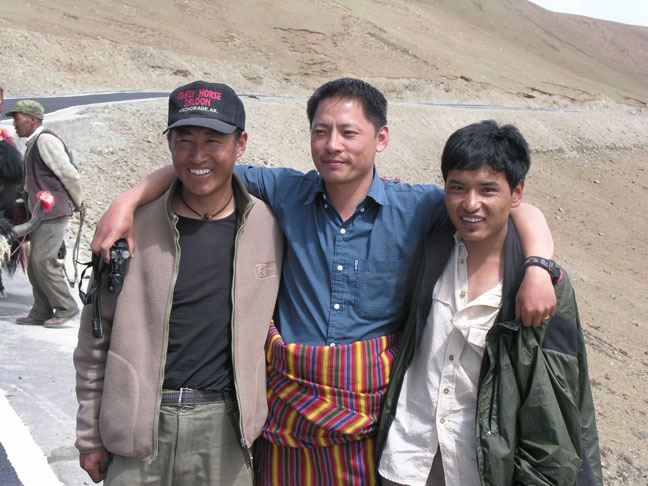
Our journey by bus from the Gongkar airport to Lhasa was along the Yarlung
Tsangpo and Kyi Chu (rivers). They are very wide, with many channels
and huge sand bars. Only part of the floodplain is available for agriculture
and tree planting. The strong winds blow sand high (>1000') up into
the mountains, making spectacular climbing dunes. We witnessed a sand
storm across the valley. 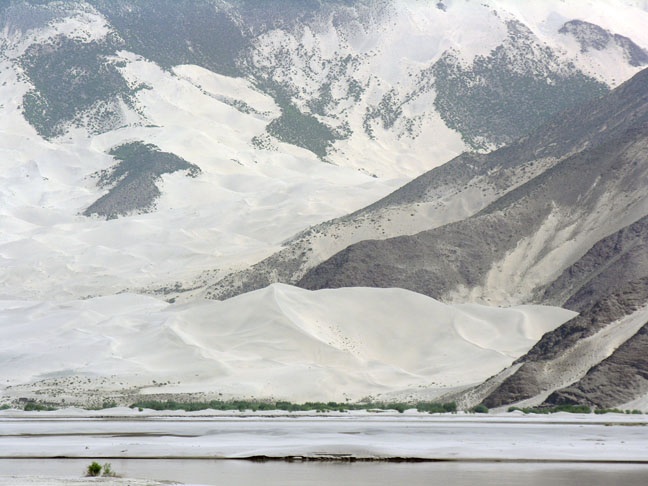
The rocks
are clastic sedimentary rocks (India), granite (under volcanic arc),
and limestone (Tethys Sea and/or Eurasia and/or Lhasa block). The Gangdisc
Granite is part of a volcanic-plutonic complex related to India being
subducted beneath the Llasa block, which joined Eurasia before India
did.
Tibet and Lhasa have been and continue to be overrun by Chinese. But
there is a Tibetan part of Lhasa, and that's where we walked today.
Traffic has been blocked from a shopping area around the Jokhang.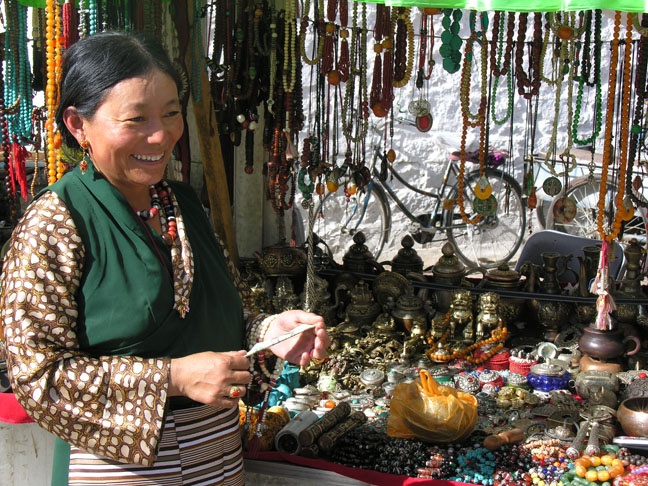 There are hundreds of shops and booths, where for sale are jewelry,
religious items, cloth, etc. Beth Blum and I bargained for a purse,
turquoise, prayer bowls, and a bell. The sales ladies started high,
and in each case, with as much as a half hour of polite bickering, we
got prices cut in half or a little more. It was fun, and there were
plenty of smiles.
There are hundreds of shops and booths, where for sale are jewelry,
religious items, cloth, etc. Beth Blum and I bargained for a purse,
turquoise, prayer bowls, and a bell. The sales ladies started high,
and in each case, with as much as a half hour of polite bickering, we
got prices cut in half or a little more. It was fun, and there were
plenty of smiles. 
I took off after a woman who was begging while guide Palden was talking.
She was dressed in traditional Tibetan garb and carried a prayer wheel.
I offered her 1 yuan (12¢) for a photo. She noisily demanded more, and
a small crowd encircled us. I showed empty pockets, pretending I had
no more money. Finally, she let me take a picture, but then again demanded
more money. I was a little nervous, but the Tibetans seemed interested,
not angry. The woman pulled at my shirt, looking for a money belt. I
lifted my shirt, revealing a hairy tummy. She shrieked and ran off,
while the others laughed.
There are one or two large loud dogs beside
our hotel, just beneath our windows. They bark on and off 24 hours a
day. I could hear them even with earplugs. I did not get much sleep
tonight, but I have not been sleeping well since Walla Walla. I'm very
surprised that Clare and I each have a little high-altitude sickness
at 11,975' - shortness of breath, headaches. We were OK at almost the
same elevation in the Andes in both 2000 and 2002. Then we were not
taking diamox, which are to help with acclimatization. It may partly
be the sun and aridity.
June
2: Lhasa II (Jokhang and Sera)
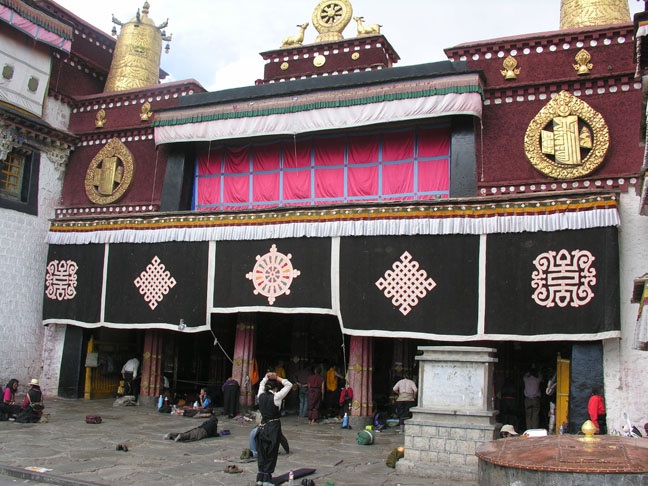 In
the morning we explored the Jokhang temple, which contains a statue that
somehow has survived for 2500 years (kings, Dali Lamas, and the Chinese
invasion). Because this is an auspicious month, there are more pilgrims
than ever prostrating themselves in front of and within this huge temple.
There are 3 koras (walks, always clockwise) the pilgrims can take here:
the shortest is inside the Jokhang, the next is around the temple's perimeter
(<1 km), and the longest is all the way around Lhasa (5-hour walk). In
the morning we explored the Jokhang temple, which contains a statue that
somehow has survived for 2500 years (kings, Dali Lamas, and the Chinese
invasion). Because this is an auspicious month, there are more pilgrims
than ever prostrating themselves in front of and within this huge temple.
There are 3 koras (walks, always clockwise) the pilgrims can take here:
the shortest is inside the Jokhang, the next is around the temple's perimeter
(<1 km), and the longest is all the way around Lhasa (5-hour walk). 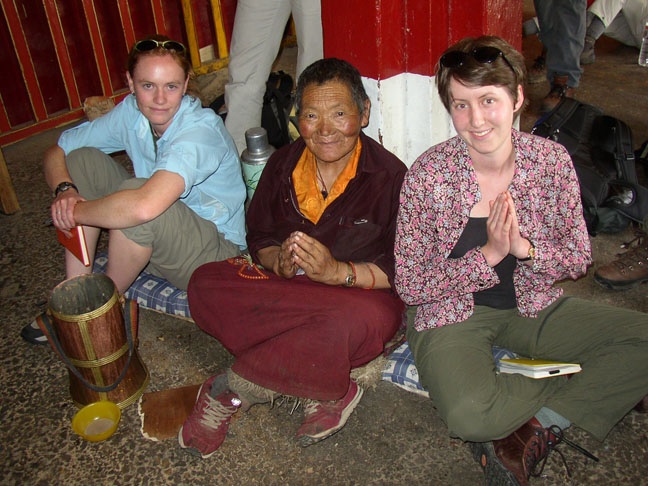
The Jokhang is the most revered religious structure
in Tibet. It dates from the seventh century, but most had to be rebuilt
after the twentieth century Cultural Revolution. It shares many features
in common with other Tibetan Buddhist temples and monasteries:
1) many
side chapels
2) many, many “statues” of Buddhas, high lamas
3) many
yak butter and wheat flour figures
4) millions of bills, mostly small
and Chinese, as offerings from pilgrims and other visitors
The afternoon
was spent at Sera Monastery just north of Lhasa; it was once home for
5000 monks. For me, this was the most interesting monastery of the trip
for two reasons: (1) it includes a huge print shop (hand printing with
wooden blocks) and library; and (2) we got to hear monks debate and
then chant. About 400 monks debated (mostly in pairs, with a lot of
hand gestures) and then chanted (including some solo throat singing).
After touring the inside of the monastery, we did a kora (walked around
the perimeter, including climbing a little way up the granite slope
behind the monastery).
The religious devotion of Buddhists must be greater
than that of any other faith. Some walk (or even prostrate themselves)
for days to go to a temple. They give lots of money in temples and monasteries
(support for monks and nuns). They pray a lot, with prayer flags, prayers
on small pieces of paper scattered from high places, prayer bowls, and
prayer wheels, carried while they walk.
June
3 : Lhasa III (Pabonka)
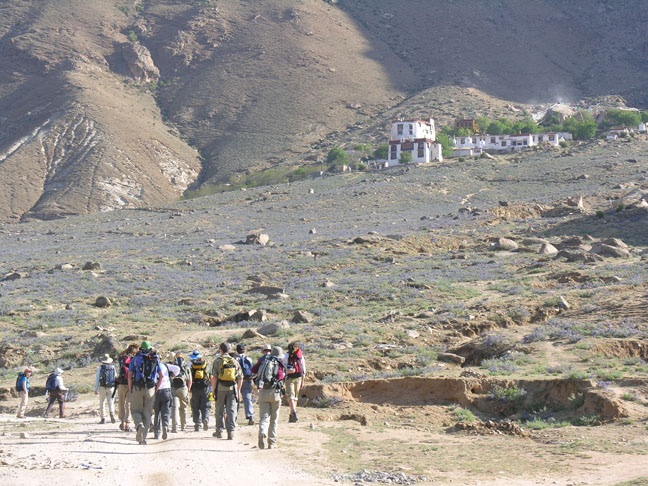 Today
we hiked up to lower Pabonka Monastery, and looked at a holy cave in
the granite. Outside were many hoopoes, birds which make a sound like
their name, and are quite colorful. On the way farther up to upper Pabonka
Monastery, we looked down on a sky burial site. Most Tibetans have their
bodies cut into parts and their bones crushed, all to be placed where
vultures, wild dogs, etc., can feast. We saw hundreds of Today
we hiked up to lower Pabonka Monastery, and looked at a holy cave in
the granite. Outside were many hoopoes, birds which make a sound like
their name, and are quite colorful. On the way farther up to upper Pabonka
Monastery, we looked down on a sky burial site. Most Tibetans have their
bodies cut into parts and their bones crushed, all to be placed where
vultures, wild dogs, etc., can feast. We saw hundreds of 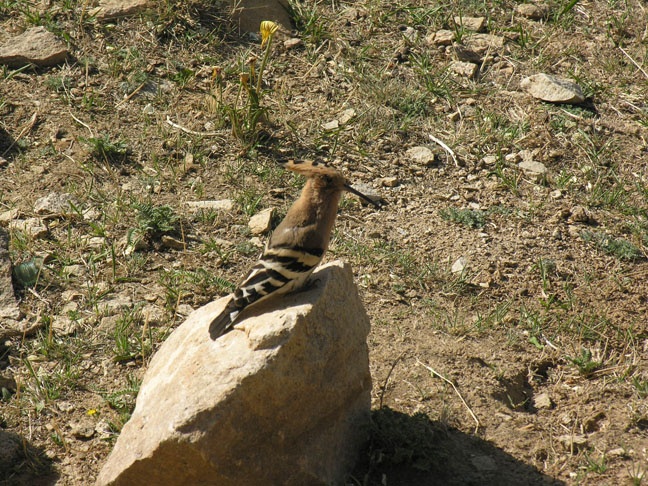 Himalayan
griffons perched on ridges and circling above the site. Himalayan
griffons perched on ridges and circling above the site.
Past the second monastery we crossed a gorge and climbed up to a cave in the granite cliff where two nuns live. There is a small spring, but they must carry food and fuel wood up. Also they have a solar cooler.
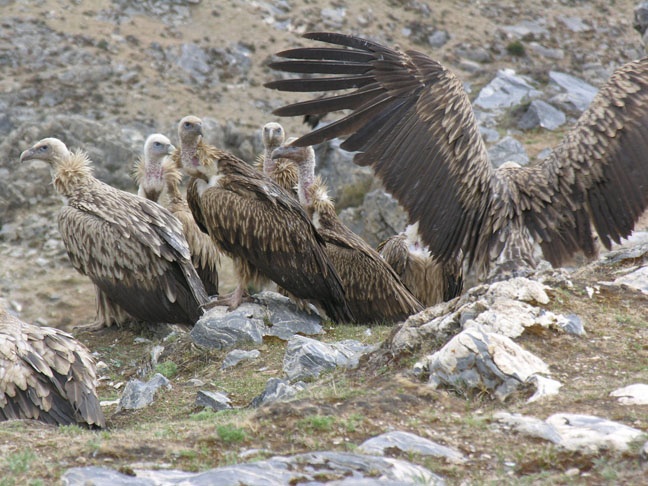 In
the late afternoon we visited a carpet factory. Tibetan carpets are
thick, dense, and beautiful. We watched them being woven, then went
into the showroom. Most students bought as least one carpet - the variety
of size and design is great. The less regular the design, the more expensive,
so a 1-m2 carpet price ranged from $100 to $400. Palden bought a large
carpet for his wife and 7-month-old daughter - it has a dragon and a
crane. We bought a mandala carpet and 3 small carpets. Adjacent is a
Chinese gift shop, which has old hand-stitched “paintings” in the $4000
price range. In
the late afternoon we visited a carpet factory. Tibetan carpets are
thick, dense, and beautiful. We watched them being woven, then went
into the showroom. Most students bought as least one carpet - the variety
of size and design is great. The less regular the design, the more expensive,
so a 1-m2 carpet price ranged from $100 to $400. Palden bought a large
carpet for his wife and 7-month-old daughter - it has a dragon and a
crane. We bought a mandala carpet and 3 small carpets. Adjacent is a
Chinese gift shop, which has old hand-stitched “paintings” in the $4000
price range.
June
4: Lhasa IV (Potala and Dungkar)
 We
finally got to visit the Potala, probably Tibet's most famous landmark.
I wonder if it is the largest building on earth. Perched on an erosion
remnant of sedimentary rocks rising 130 m above the floodplain of the
Kyi Chu (on which Lhasa is built), the Potala is like a huge museum
because the current Dalai Lama is in exile in India. Although it is
our fourth day in Tibet, I felt the altitude climbing from the floodplain
(elevation almost 12,000') to the top of the palace. We
finally got to visit the Potala, probably Tibet's most famous landmark.
I wonder if it is the largest building on earth. Perched on an erosion
remnant of sedimentary rocks rising 130 m above the floodplain of the
Kyi Chu (on which Lhasa is built), the Potala is like a huge museum
because the current Dalai Lama is in exile in India. Although it is
our fourth day in Tibet, I felt the altitude climbing from the floodplain
(elevation almost 12,000') to the top of the palace.
In the center of the Potala is the red palace, a religious portion with
many chapels and a large meeting hall; it includes a stupa for Dalai
Lama V (he is “buried” there) containing 3721 kg of gold (about $50
million). At one end of the Potala is the white palace, the living quarters
of the Dalai Lama (we were able to go into four of his rooms, including
where political meetings were held). The other end of the Potala, also
painted white, was the home of exactly 175 monks.
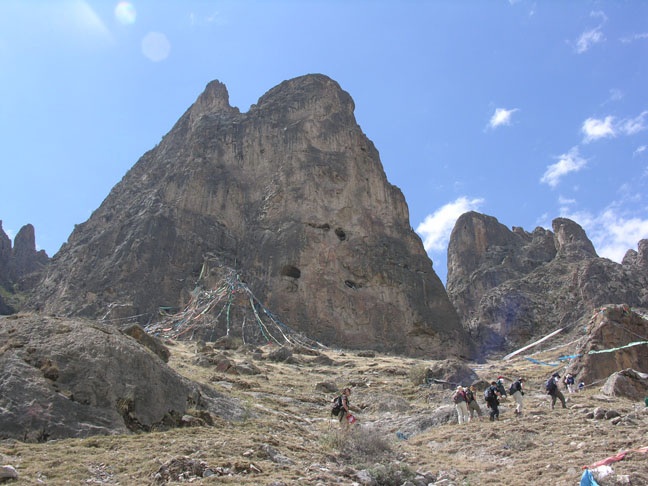 Massive
vertical high cliffs and towers of limestone at Dungkar provided shade
at the top of today's hike, which turned out to be a geology-biology
field trip. Below we looked past a quarry (occasional blasts) up the
Kyi Chu valley to the Potala and another erosion remnant. To the south
were the highway, with a Chinese army convoy, the southwest end of Lhasa
with buildings and trees, the wide braided river, climbing dunes, and
mountains with a few tiny snow patches. In the distance was what we
were unsure was a rainstorm or a dust storm. These cliffs have wildflowers,
mammals, and birds, and dry caverns. The guides caught a pika. We lingered,
looked, and talked before descending through giant boulders to the bus. Massive
vertical high cliffs and towers of limestone at Dungkar provided shade
at the top of today's hike, which turned out to be a geology-biology
field trip. Below we looked past a quarry (occasional blasts) up the
Kyi Chu valley to the Potala and another erosion remnant. To the south
were the highway, with a Chinese army convoy, the southwest end of Lhasa
with buildings and trees, the wide braided river, climbing dunes, and
mountains with a few tiny snow patches. In the distance was what we
were unsure was a rainstorm or a dust storm. These cliffs have wildflowers,
mammals, and birds, and dry caverns. The guides caught a pika. We lingered,
looked, and talked before descending through giant boulders to the bus.
This evening we had dinner at a restaurant which included a cultural
show after dessert. We heard traditional Tibetan music and watched women
and men dance, with many changes of costume.
June
5: Lhasa - Ganden
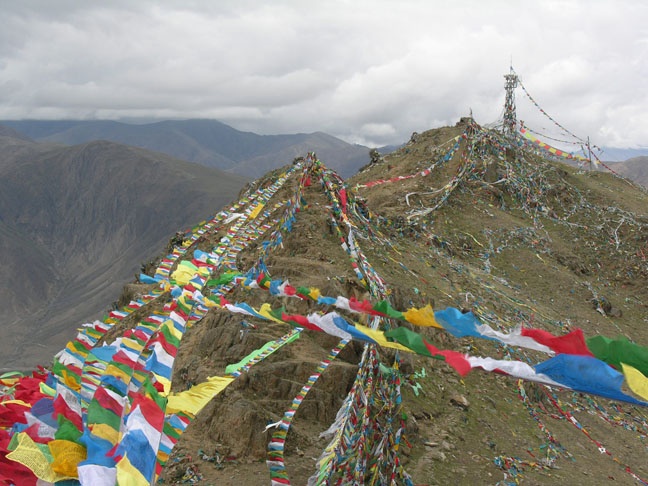 Two
thirds of us are now (or have been) sick in one way or another - in all
but one case it is diarrhea and/or throwing up, in many cases severely.
Some cannot sleep or eat. Two
thirds of us are now (or have been) sick in one way or another - in all
but one case it is diarrhea and/or throwing up, in many cases severely.
Some cannot sleep or eat.
We drove 40 km northeast from Lhasa up the Kyi Chu valley. The last part
of the route is a dirt road with many switchbacks. At one turn dozens
of Himalayan griffons (vultures) feasted on a dead yak. From the high
Ganden Monastery we saw that new 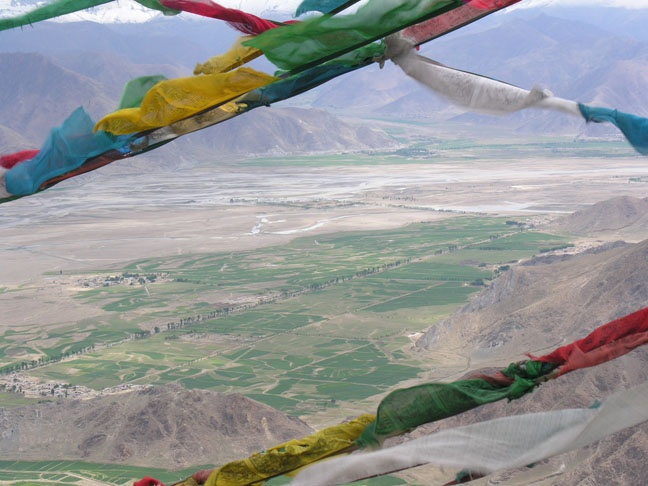 snow
fell above 4500 m last night. snow
fell above 4500 m last night.
Today's hike, for those who made it, was our favorite. The geology is
fascinating, and the wildflowers varied. We discovered an explosive
volcanic complex, weakly metamorphosed: greenstone dikes, tuff breccia
with fiamme. We ascended a ridge the long way, then followed the little
peaks with thousands, perhaps millions of prayer flags; and descended
to Ganden Monastery. It was nice not to have to share the monastery
with hordes of pilgrims and tourists. The views of and from the monastery
are spectacular, down to the wide braided Kyi Chu, and over to snowy
mountains.
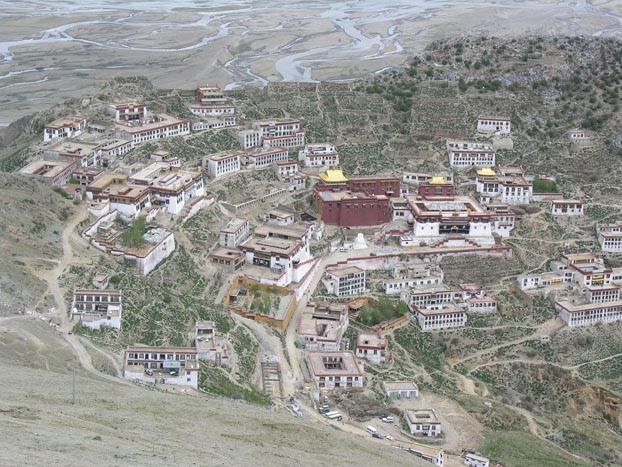 Ganden
Monastery was founded in 1409. It is being rebuilt after complete destruction
by artillery fire not only in 1959 but also in 1966. Ganden
Monastery was founded in 1409. It is being rebuilt after complete destruction
by artillery fire not only in 1959 but also in 1966.
June
6 : Lhasa - Shigatse (via Shogu La and Dongu La)
Today we drove up and down river valleys crossing the southern Tibetan
Plateau, and reaching its southern edge where the Yarlung Tsangpo forms
its border with the Himalayas, or where India meets Eurasia in the geologic
sense. There was more new snow last night, which helped to emphasize surficial
patterns like polygons 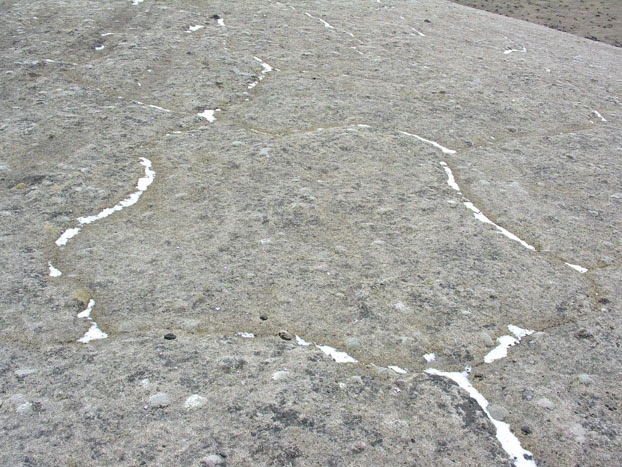 above
permafrost. It is extremely bright at 17,000' with new snow, with or without
the sun. Up on the plateau the temperature was just above or below freezing,
with mostly clouds. By the time we turned west on the Yarlung Tsangpo
the clouds had disappeared and the temperature had climbed 30 to 40º. above
permafrost. It is extremely bright at 17,000' with new snow, with or without
the sun. Up on the plateau the temperature was just above or below freezing,
with mostly clouds. By the time we turned west on the Yarlung Tsangpo
the clouds had disappeared and the temperature had climbed 30 to 40º.
There are yaks everywhere! The nomadic herders have dark colored rectangular
tents with sloping roofs and sides. They tend  goats
and sheep as well as yaks. goats
and sheep as well as yaks.
In contrast, down on the wide flood plain there are dunes, irrigation
ditches, agricultural plots, and afforestation to reduce erosion, sequester
carbon, or whatever.
A lot of students are still sick; all could not make it to dinner. The
nine-hour Land Cruiser ride, mostly on bumpy roads did not help, nor did
altitudes as high as 17,000'. The six Tibetan drivers are very nice, and
quite sympathetic to the students' illnesses. Clare and I were in the
lead vehicle with guide Lhada. 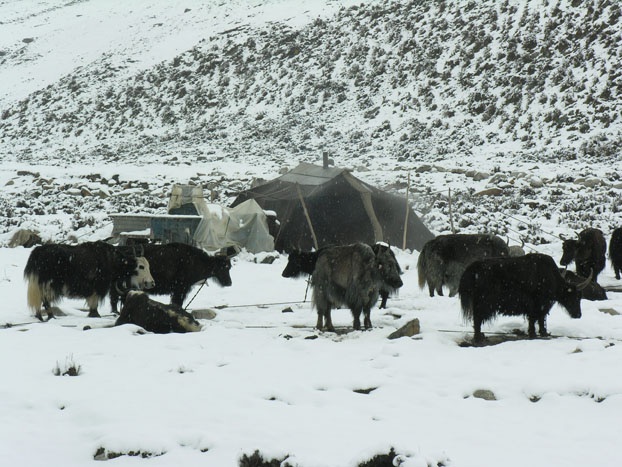
June
7: Shigatse - Gyantse
Plate
tectonics was the theme of our long morning roundtrip drive between Shigatse
and Gyantse. At Shigatse the clastic sedimentary rocks were marine sediments
deposited on the south edge of the passive margin of Eurasia. In contrast,
at Gyantse similar sediments were deposited on the north edge of the active
margin of India. Between the two continents was the Tethys Sea, underlain
by oceanic crust. As the two continents collided, a piece of oceanic crust
was caught in the vice. We stopped at three places to sample the oceanic
crust (pillow basalts and red chert at the top, with sheeted dikes beneath)
and upper mantle (serpentinite).
 The
claim to fame in the Pelkor Chode Monastery in Gyantse is the Gyantse
Kumdum, Tibet's largest stupa (35 m high). We got good views of the stupa
from the highest point within the monastery, sitting on a hillside and
surrounded by a wall. In the distance we saw another fortress-like monastery.
Bhutan lies to the south of Gyantse; British troops came here in 1904,
on their way to Lhasa. The
claim to fame in the Pelkor Chode Monastery in Gyantse is the Gyantse
Kumdum, Tibet's largest stupa (35 m high). We got good views of the stupa
from the highest point within the monastery, sitting on a hillside and
surrounded by a wall. In the distance we saw another fortress-like monastery.
Bhutan lies to the south of Gyantse; British troops came here in 1904,
on their way to Lhasa. 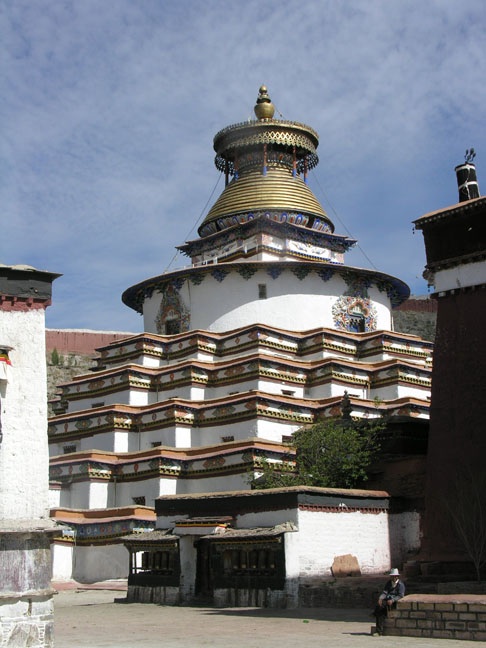
After a late lunch we explored the Tashilhunpo Monastery, founded in
1447. The remains of the first Dalai Lama are here. The monastery includes
a 90-year-old (hollow) copper statue. The tombs of many Panchen Lamas
(second only to Dalai Lamas) are within the monastery.
Shigatse is the second largest city in Tibet. The Shigatse market outdoes
the Lhasa Tibetan business area in terms of the passion of the sales
persons, mostly women in traditional clothes. We walked through the
stands of jewelry, gift items, etc. Nearby were foods, and cloth. Men
played pool and craps.
Generally one can get about half of what they ask, sometimes one third
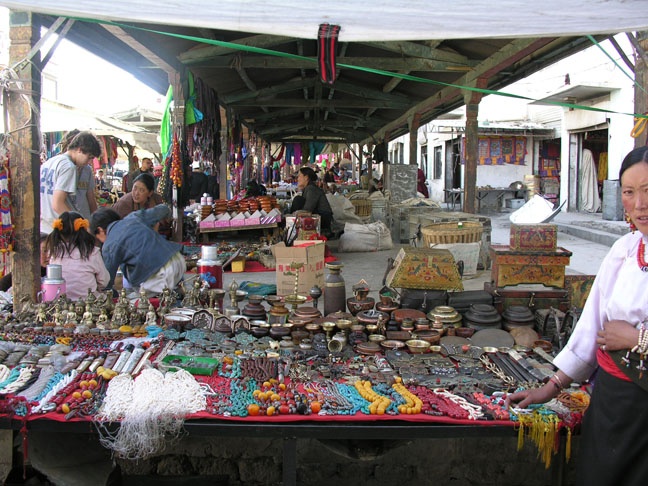 if
you are persistent and/or walk away. At one time I had five women tugging
at me trying to get me to buy their wares. Some, including Clare, almost
had to wrestle themselves away from aggressive salespersons. You hear
many phrases like “cheap”, “how much”, “lowest”, “final”, “me poor”, and
“look” repeatedly. I love the bargaining. if
you are persistent and/or walk away. At one time I had five women tugging
at me trying to get me to buy their wares. Some, including Clare, almost
had to wrestle themselves away from aggressive salespersons. You hear
many phrases like “cheap”, “how much”, “lowest”, “final”, “me poor”, and
“look” repeatedly. I love the bargaining.
The food here is very similar at breakfast, lunch, and dinner: jasmine
tea, water or coke or sprite, mixtures of meat and vegetables, rice,
noodles, soup, tofu. There is no salad, and little if any bread. Dessert
is apple wedges. The hotel employees are all very friendly.
June
8 : Shigatse - Sakya
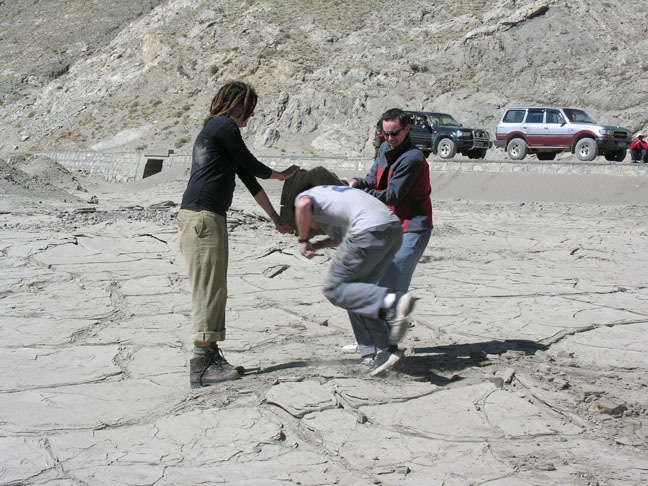
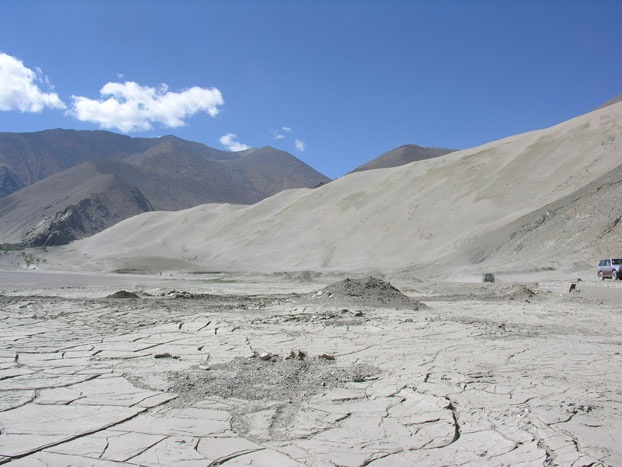 Today we crossed the Yarlung Tsangpo and drove east (upvalley) along
the north shore. There are many dunes along the river.
Today we crossed the Yarlung Tsangpo and drove east (upvalley) along
the north shore. There are many dunes along the river.
Today and two days ago and at Ganden Monastery we had a picnic lunch
outside. Nomads, as Palden calls them, appear and watch you eat, knowing
that they will get the leftovers, which are considerable. They take
not only the food, but the trash. They love the 1.5-liter water bottles.
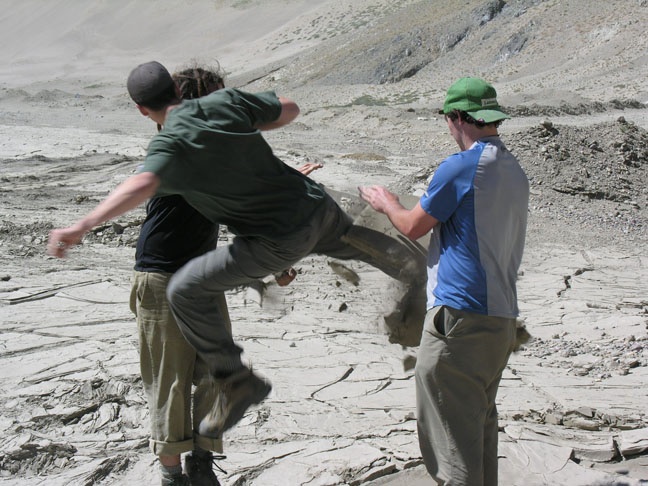 They bring us a water bucket or some other container for our leftover
rice. The cardboard and paper is good for starting fires. Two days ago
they brought baby goats to show us. In general they do not want their
pictures taken; but if they do, they enjoy seeing the digital photos
on the screen.
They bring us a water bucket or some other container for our leftover
rice. The cardboard and paper is good for starting fires. Two days ago
they brought baby goats to show us. In general they do not want their
pictures taken; but if they do, they enjoy seeing the digital photos
on the screen.
After lunch we continued through road construction and finally a paved
road to Shigatse, the capital of Tibet from 1268 to 1354. During this
time Tibetan Buddhism spread to Mongolia, and the Monguls spared Tibet.
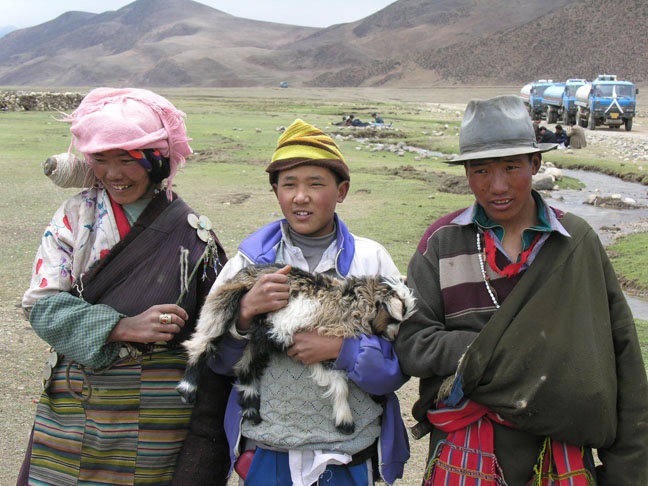 There are a few peaks to the south with a snow caps, and as we left
the Yarlung - Tsangpo we saw many more, perhaps even one glacier. All
the hills and mountains are very dry, with next to no vegetation. This
contrasts sharply with the green flood plains, with many fields, often
with a rock in the center. We also saw lots of cottonwood afforestation
of the flood plain.
There are a few peaks to the south with a snow caps, and as we left
the Yarlung - Tsangpo we saw many more, perhaps even one glacier. All
the hills and mountains are very dry, with next to no vegetation. This
contrasts sharply with the green flood plains, with many fields, often
with a rock in the center. We also saw lots of cottonwood afforestation
of the flood plain. 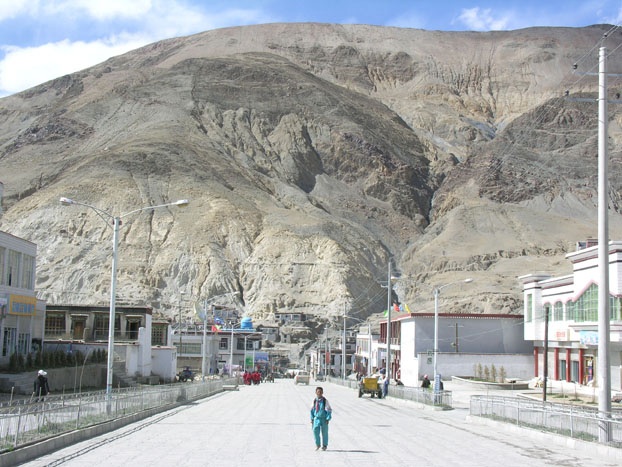
Sakya is small, and mostly modern and Chinese, except for the monastery
near out hotel. There's another monastery with stupas across the valley
to the north. The one we explored is notable for support pillars 1m
in diameter, juniper trees brought 600 km from southeastern Tibet.
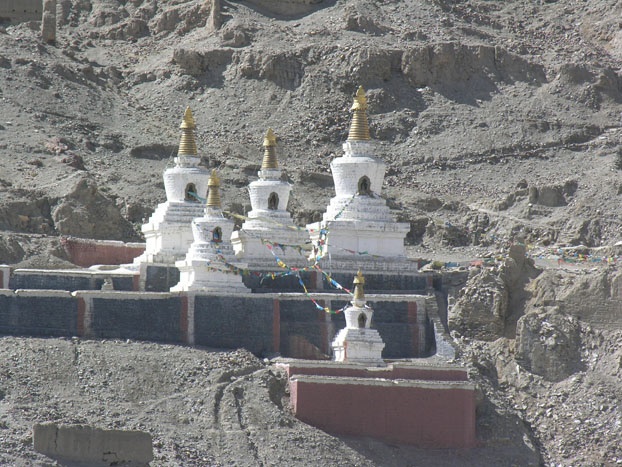
June
9 : Sakya - Rongbuk (via Dong La and Pang La)
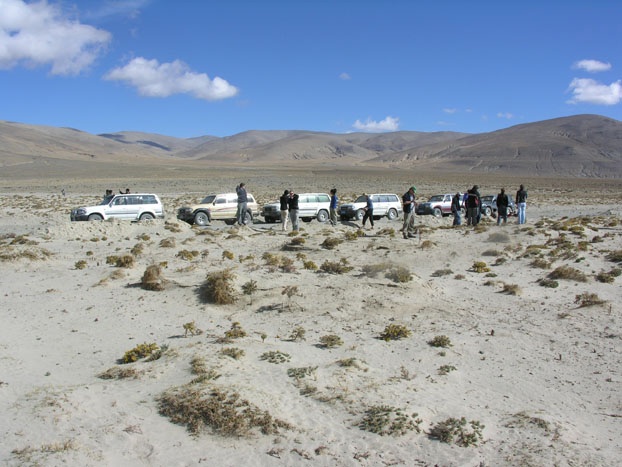 Today was a really tough day in the vehicles: long, bouncy, dusty, warm.
We took a route the guides had never been
Today was a really tough day in the vehicles: long, bouncy, dusty, warm.
We took a route the guides had never been 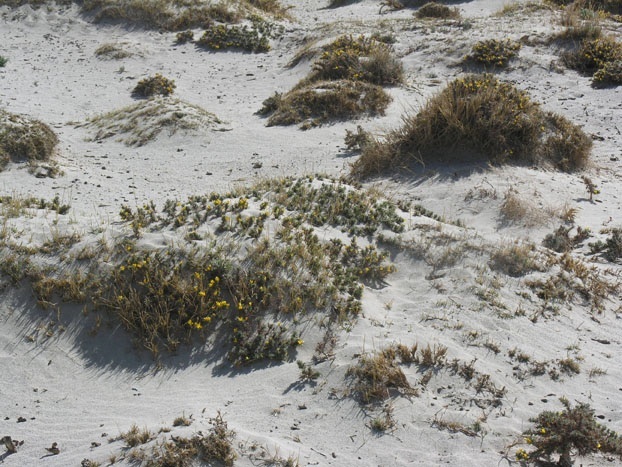 before.
Often the vehicles needed 4WD for loose sand. We splashed across some
streams. We encountered our first bothersome tiny insects (by the millions)
at an intended lunch stop by a river, but moved west. before.
Often the vehicles needed 4WD for loose sand. We splashed across some
streams. We encountered our first bothersome tiny insects (by the millions)
at an intended lunch stop by a river, but moved west.
The geology was spectacular: intensely folded clastic sedimentary rocks,
plus a little limestone and gneiss. These hillsides are unraveling, and
have giant alluvial fans at their bases. We drove through tens of kilometers
of coppice dunes with yellow gorse-like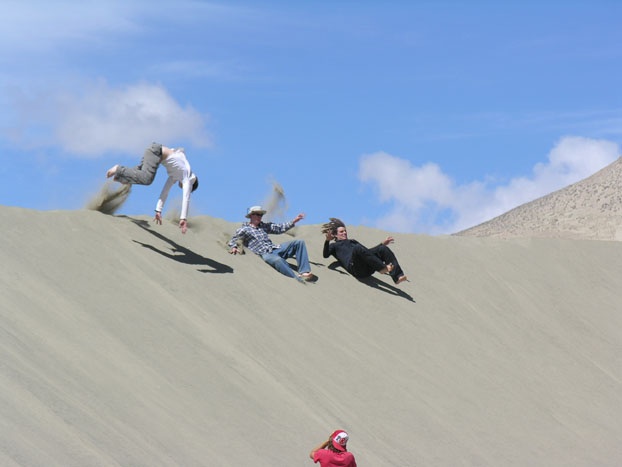 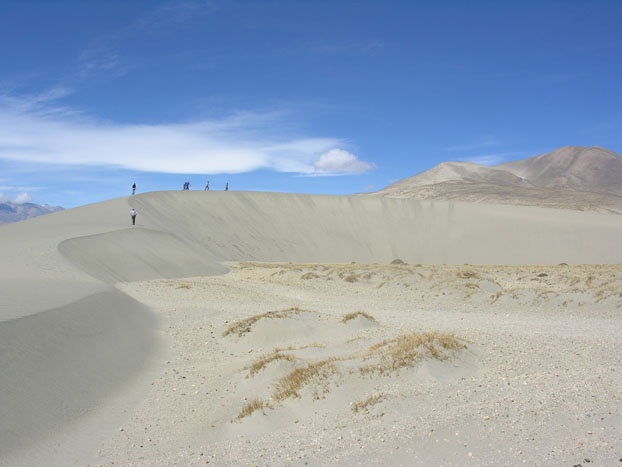 shrubs/flowers anchoring them. And we played on textbook barchans. From
two passes we had great views of the high Himalayas. All the villages
have red and black stripes on gray walls. The weather continues to be
beautiful.
shrubs/flowers anchoring them. And we played on textbook barchans. From
two passes we had great views of the high Himalayas. All the villages
have red and black stripes on gray walls. The weather continues to be
beautiful.
This afternoon we entered Qomolangma National Nature Preserve (e.g., Mt.
Everest national park). From the entrance one drives over Pang La (a pass
about 17,000' high) for a spectacular view of high Himalaya peaks. Near
Posum we traded our Toyota Land Cruisers for official tourist vans and
drove upvalley, the views of Mt. Everest and nearby snowy peaks getting
better and better.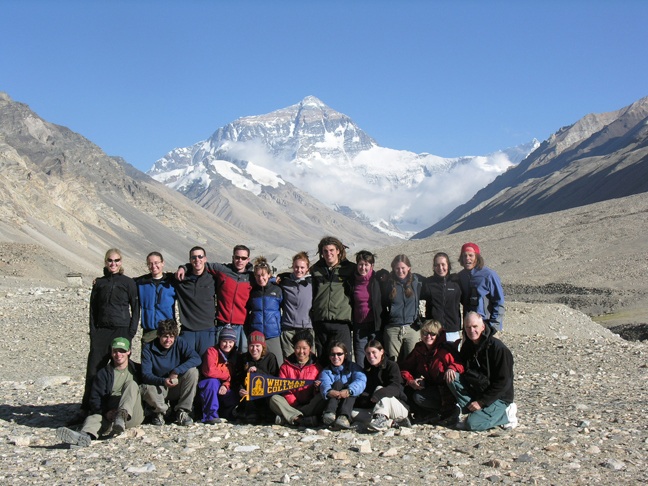
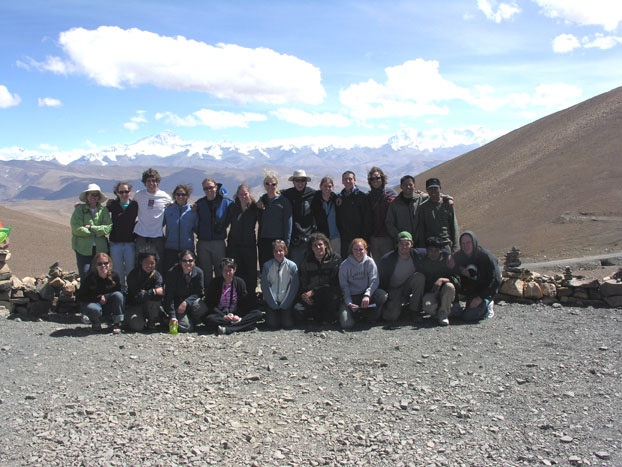 I
took pictures of the north side of Mt. Everest, and nearby lateral moraines,
before coming into the hotel in the Rongbuk Valley. I lie on my bed looking
at the north face of Mt. Everest, with clear blue sky rising above the
29,000' peak (only 13,000' above us). I
took pictures of the north side of Mt. Everest, and nearby lateral moraines,
before coming into the hotel in the Rongbuk Valley. I lie on my bed looking
at the north face of Mt. Everest, with clear blue sky rising above the
29,000' peak (only 13,000' above us).
June
10 : Everest I (Base Camp)
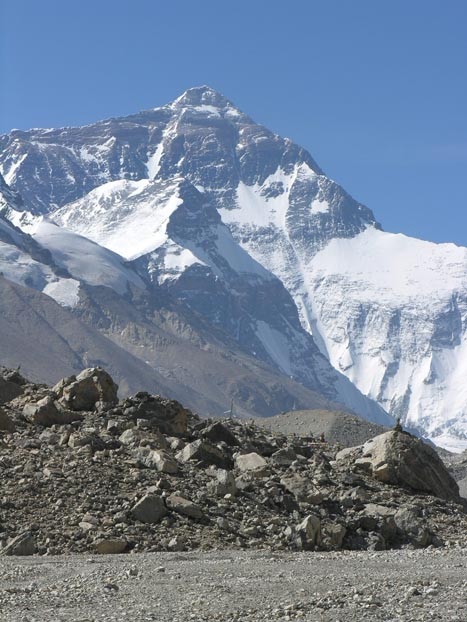 Today
we hiked to two caves, one very holy, about 5 km upvalley from the hotel.
The caves are in a huge rockfall with giant boulders of gneiss and migmatite.
We saw slicklenlines, garnets, and tourmalines. Most returned to the hotel
for a late lunch, but four of us hiked to Everest Base Camp at 16,900'
(another 3.5 km upvalley). There we had a light lunch in one of many tents,
and checked out tomorrow's route. In the afternoon there is a very Today
we hiked to two caves, one very holy, about 5 km upvalley from the hotel.
The caves are in a huge rockfall with giant boulders of gneiss and migmatite.
We saw slicklenlines, garnets, and tourmalines. Most returned to the hotel
for a late lunch, but four of us hiked to Everest Base Camp at 16,900'
(another 3.5 km upvalley). There we had a light lunch in one of many tents,
and checked out tomorrow's route. In the afternoon there is a very  strong
downvalley katabatic wind off the glaciers. After viewing Everest and
Nuptse, we hiked back to the hotel. strong
downvalley katabatic wind off the glaciers. After viewing Everest and
Nuptse, we hiked back to the hotel.
What good fortune to have had clear weather all day. The sun hits Everest
from 7am to 9pm, the light on the cliffs and snowfields changing all day.
This valley has “textbook” glacial geology, with four terminal moraine
complexes from just above Base Camp (below stagnant ice of the Rongbule
Glacier) to below the hotel. 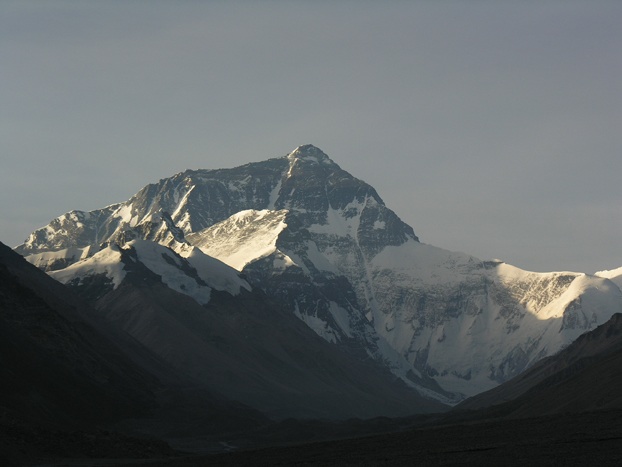 The
steep valley sides are mostly covered with colluvium - there is till and
gneiss in places. The beauty leaves no doubt as to why this was the second
holiest place in Tibet (after Mt. Kalish at the headwaters of Yarlung
Tsangpo). The
steep valley sides are mostly covered with colluvium - there is till and
gneiss in places. The beauty leaves no doubt as to why this was the second
holiest place in Tibet (after Mt. Kalish at the headwaters of Yarlung
Tsangpo).
June
11 : Everest II (Camp I)
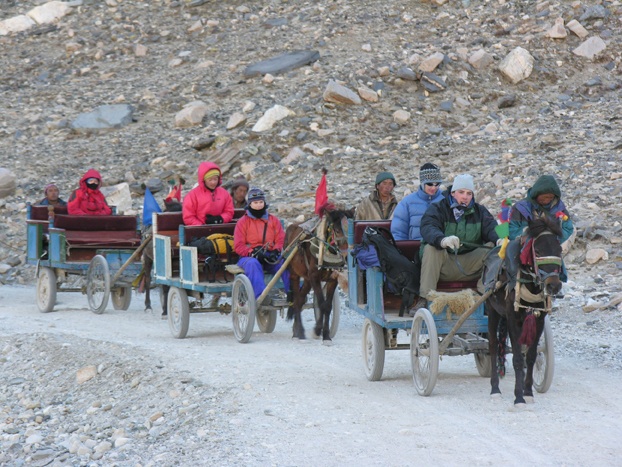 The
hotel employees awoke late, so our 7am breakfast was late. Horse carts
that carry driver (except going uphill) and two passengers awaited us
right at the hotel's front door. The 11 carts are blue, pulled by decorated
horses. The back seat is particularly bumpy, and in the early morning
shade, we had no sun until Base Camp. It took 1.5 hours to get the 9
km from the hotel (16,350') to the north Everest Base Camp (16,900'),
where the sun greeted us. The
hotel employees awoke late, so our 7am breakfast was late. Horse carts
that carry driver (except going uphill) and two passengers awaited us
right at the hotel's front door. The 11 carts are blue, pulled by decorated
horses. The back seat is particularly bumpy, and in the early morning
shade, we had no sun until Base Camp. It took 1.5 hours to get the 9
km from the hotel (16,350') to the north Everest Base Camp (16,900'),
where the sun greeted us. 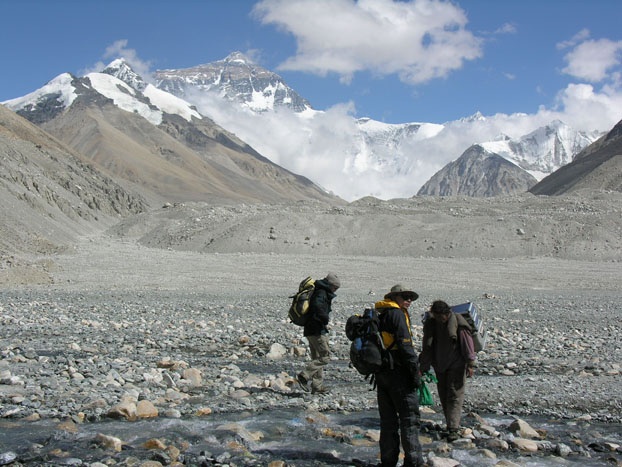 We
had 8 hours to get back to Base Camp at 6pm, and return to the hotel
by horse cart. We
had 8 hours to get back to Base Camp at 6pm, and return to the hotel
by horse cart.
Of course, the view of the Rongbuk Valley and Mt. Everest and surrounding
Himalayan peaks and glaciers is spectacular - all day! From Base Camp
we hiked across a relatively flat outwash plain, but had to cross two
channels of a fast stream that is a tributary to the Rongbuk River.
The guides threw huge rocks into
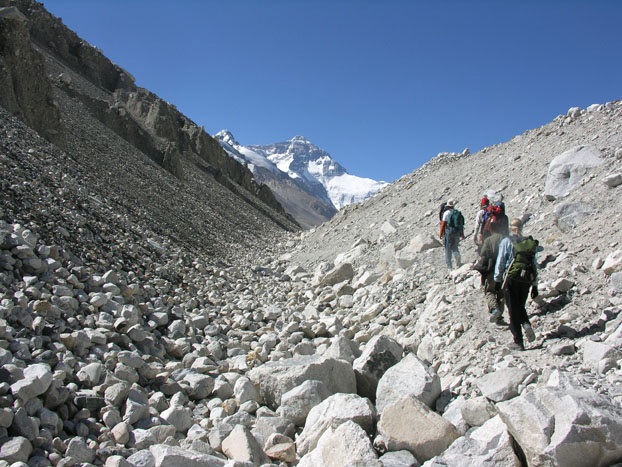 the water, and held our hand to make the crossing easier. I was a little
too sure of myself - my foot slipped off an ice-coated rock and I fell
- fortunately I was not injured and only got one sock a little wet.
the water, and held our hand to make the crossing easier. I was a little
too sure of myself - my foot slipped off an ice-coated rock and I fell
- fortunately I was not injured and only got one sock a little wet.
Mornings generally have a gentle upvalley wind, and afternoons a very
strong downvalley wind. With a bright sun, or gentle ascent, and a little
wind, we quickly removed most of the clothes we had worn on the chilly
horse cart ride (for me it had been 3 layers down 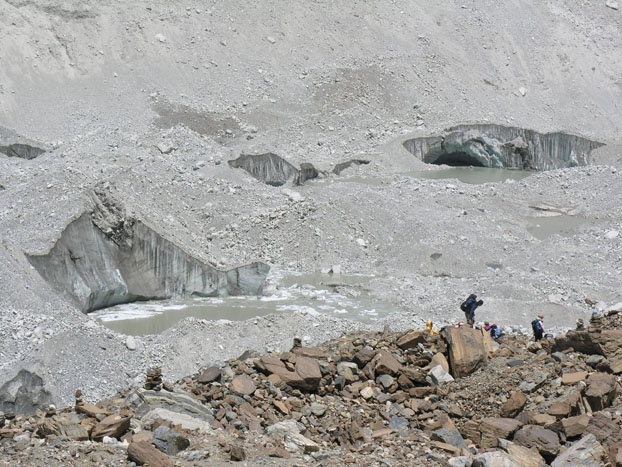 and
5 layers up). The subfreezing night temperatures rise to 50º or 60ºF
during the day. and
5 layers up). The subfreezing night temperatures rise to 50º or 60ºF
during the day.
For about 5 km we ascended from 17,000' to 17,500' on a gentle gradient.
The route is used by dozens of Himalayan expeditions trying to climb
Mt. Everest from the north. Even yaks can carry loads from Base Camp
to Camp I, which is at the foot of the East Rongbuk Glacier. This gradual
ascent is mostly between the right lateral moraine of the Rongbuk Glacier
and the east valley side, but here and there the route goes
up onto the moraine for a view of the stagnant glacier. Above Everest
Base Camp is the terminal moraine (Little Ice Age, or younger?) of the
Rongbuk Glacier; upvalley there are two lateral moraines, between which
is stagnant ice, mostly debris covered. Foliated ice shows in places,
and there are many green meltwater kettle lakes. Far upvalley one can
see the highly crevassed active ice of the Rongbuk Glacier.
The farther upvalley we go, the more of the high Himalayan peaks we
see including Nuptse and Kalapatar. Most have much more ice on their
sides than does steeper Mt. Everest. At noon the wind shifted from upvalley
to downvalley, and we reached the point where the East Rongbuk River
disappears under the stagnant Rongbuk Glacier. This became our lunch
stop, with a great view down onto the Rongbuk Glacier, and across to
its left lateral moraine, and upvalley to the glory of steep icy peaks
reaching two miles above us.
One option was crossing the East Rongbuk River (potentially dangerous)
and continuing up the east side of the Rongbuk Valley, but (1) we would
not have gained much elevation; and (2) the view would not have changed
much. So we made a steep ascent up the north side of the east Rongbuk
Valley, gaining 400' in about a kilometer. The view down on and across
the Rongbuk Valley got better and better as we ascended. The route became
nearly level at about 17,900'. We split at about 17,950: most continued
upvalley to Camp I 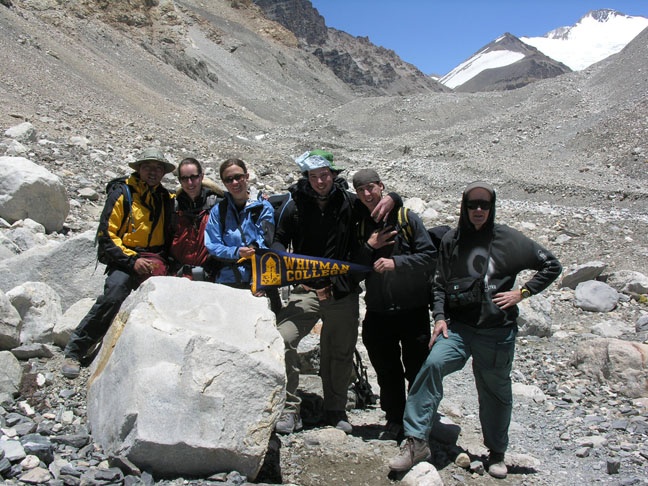 and the terminus of the East Rongbuk Glacier. Six of us climbed north
up the steep valley side to get above 18,000', I climbed higher to get
a good view of the East Rongbuk Glacier and see striations on the bedrock
walls of the glacial trough.
and the terminus of the East Rongbuk Glacier. Six of us climbed north
up the steep valley side to get above 18,000', I climbed higher to get
a good view of the East Rongbuk Glacier and see striations on the bedrock
walls of the glacial trough.
Compared with the Rongbuk Glacier, the East Rongbuk Glacier has smaller
moraines and only a short stretch of stagnant ice below the crevassed
active ice. Some of the students touched the stagnant ice above Camp
I. Most of the valley sides in this area are mantled with drift (some
lodgment till with pinnacles) and alluvial fans and talus cones. What
little bedrock shows is mostly gneiss, granite, and migmatite, generally
mafic (black) higher up and felsic (light-colored) nearer the valley
floor. The top of Mt. Everest is sedimentary rock; the glaciers bring
mudstone with cephalopod fossils down the valley.
Our turn around time was 2:30pm. Despite being quite tired, many with
headaches, 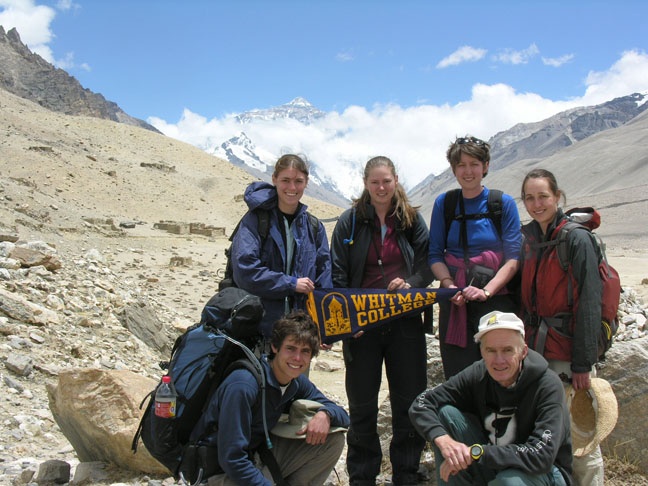 descent
was faster and easier than ascent. We retraced our ascent route exactly.
The wind was quite strong in places. The warm day dramatically increased
the discharge of the Rongbuk River and its tributaries. At the north
Base Camp we got on the bumpy horse carts to return to the hotel by
6:30pm, tired, but in great spirits. descent
was faster and easier than ascent. We retraced our ascent route exactly.
The wind was quite strong in places. The warm day dramatically increased
the discharge of the Rongbuk River and its tributaries. At the north
Base Camp we got on the bumpy horse carts to return to the hotel by
6:30pm, tired, but in great spirits.
June
12: Everest III (Rongbuk - Posum)
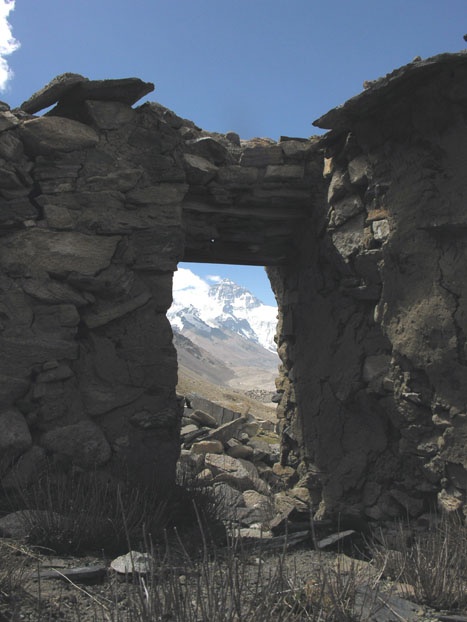 This
morning Oak and I climbed to the highest of the nunneries/monasteries
that existed before the Cultural Revolution. The Chinese destroyed them
(and paid Tibetan youth to do the same). We found lots of broken pottery.
Meanwhile, five women hiked south toward the rockfall to boulder with
their rock-climbing shoes. This
morning Oak and I climbed to the highest of the nunneries/monasteries
that existed before the Cultural Revolution. The Chinese destroyed them
(and paid Tibetan youth to do the same). We found lots of broken pottery.
Meanwhile, five women hiked south toward the rockfall to boulder with
their rock-climbing shoes.
In the afternoon seven of us (mostly geology majors) hiked north along
the road past two moraine complexes, trying to figure out the glacial
history of the Rongbuk Valley. About 2-3 km north of the hotel, the
vans, which held everyone else, picked us up for the drive to Posum.
We knew in advance that the hotel in Posum would be sketchy. There is
a ladder to the upstairs bunkrooms (holding three to ten each) and pit
toilet. We liked it until the night. On top of our coughs, earaches,
congestion, etc., an intruder came into the rooms twice, a dog barked
all night, and smoke rose from the bar/restaurant below. Many got little
sleep.
June
13: Posum - Shigatse (via Pang La and Gatso La)
Today was a long day of driving including two passes about 17,000' high.
The first, Pang La, we had been over before, but today the high Himalayas
were mostly in the clouds. On both sides of Pang La there are dozens
and dozens of switchbacks on this relatively new and good highway.
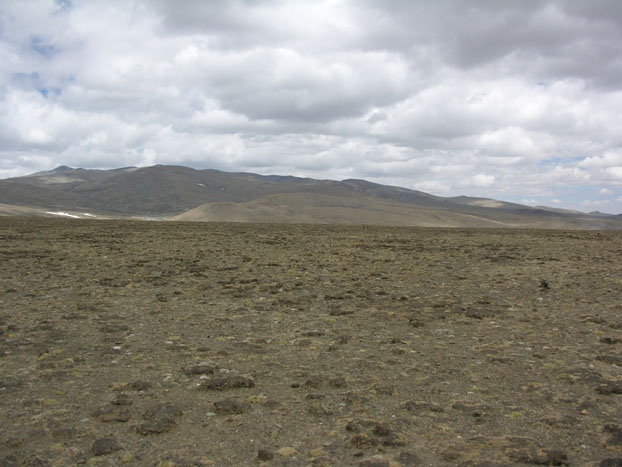 The northern pass, Maphu La, has gradual ascents from both directions.
All around is tundra, with no mountains in sight. A few small snow patches
decorated the rather barren landscape. The northern pass, Maphu La, has gradual ascents from both directions.
All around is tundra, with no mountains in sight. A few small snow patches
decorated the rather barren landscape.
We had lunch at a Chinese restaurant
in Chusar/Lhatso. Then we retraced our route of more than a week ago,
going down the Yarlung Tsangpo, mostly on the north side of the river.
The showers in the Shigatse hotel were quite welcome after almost a
week near Mt. Everest.
June
14: Shigatse - Lhasa (via Karola, Yamdrok Tso and Gampa La)
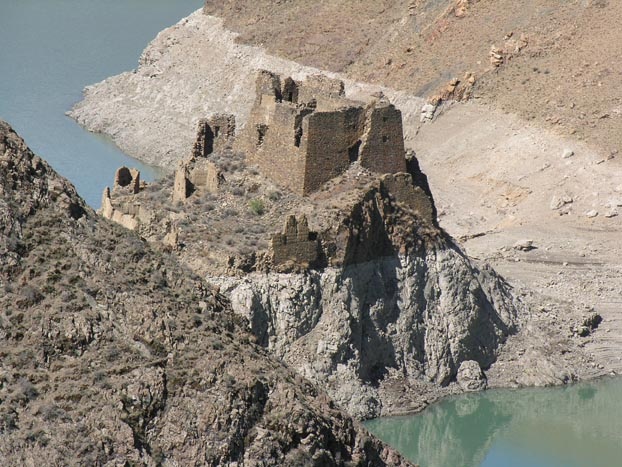 Our second day in a row of a very long drive was interesting and scenic.
The route from Shigatse south-southeast to Gyantse was a repeat. Then
the road ascended to Tibet's largest dam and long Y-shaped reservoir.
Most of the route, until we crossed the Yarlung-Tsangpo was, as usual,
sandstone and shale, green valleys and barren hillsides, giant alluvial
fans - all the sediment headed for the Bay of Bengal.
Our second day in a row of a very long drive was interesting and scenic.
The route from Shigatse south-southeast to Gyantse was a repeat. Then
the road ascended to Tibet's largest dam and long Y-shaped reservoir.
Most of the route, until we crossed the Yarlung-Tsangpo was, as usual,
sandstone and shale, green valleys and barren hillsides, giant alluvial
fans - all the sediment headed for the Bay of Bengal.
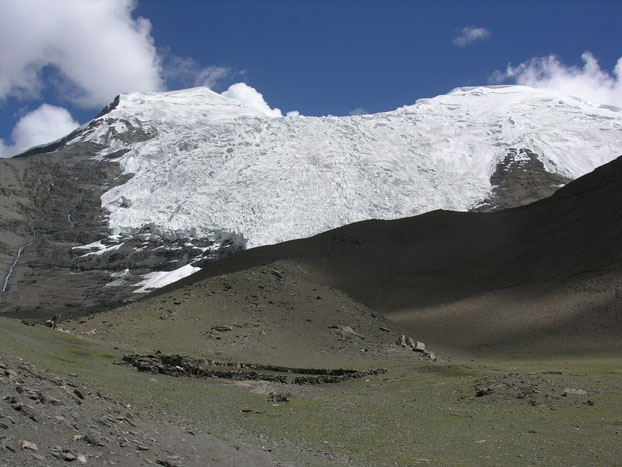 From the reservoir
the road climbed to Karo La, another almost 5000-m pass. We watched
one of Tibet's most beautiful and famous mountains, Najin Kangtsang
(over 23,000 feet) the whole way. The peak is clothed with icefalls;
at the pass we were almost under the glaciers.
From the reservoir
the road climbed to Karo La, another almost 5000-m pass. We watched
one of Tibet's most beautiful and famous mountains, Najin Kangtsang
(over 23,000 feet) the whole way. The peak is clothed with icefalls;
at the pass we were almost under the glaciers.
Descending eastward from
the pass, we soon saw Yamdrok-Tso, one of Tibet's four holy lakes. From
this huge and complexly shaped lake, pipes go north and down to the
Yarlung Tsangpo for power generation. We had a lot of delays because
of road construction by the Chinese army, but enjoyed driving along
the lake and seeing three of the rare black-necked cranes. At the pass
between the turquoise lake and the Yarlung-Tsangpo, we took pictures
of each other riding yaks. After the bridge over the Yarlung Tsangpo,
we took our earlier route to Lhasa and the nicest hotel yet.
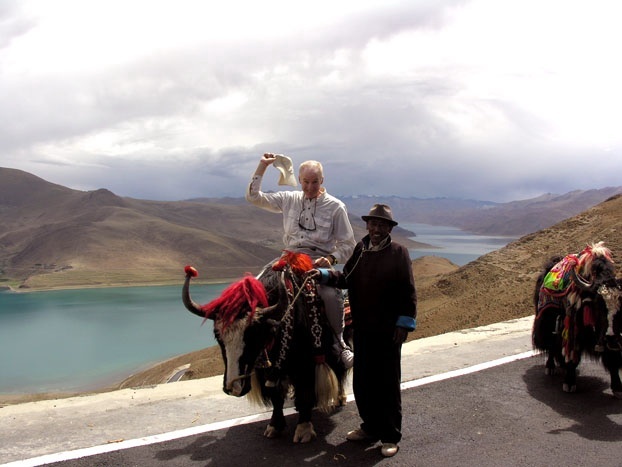 Tonight
the students returned to the bar of about a week ago. Again, when the
band took a break, four students (Egan on drums, Tyler vocal, Taylor
and a Tibetan on guitars, and in part, Miles and Taylor vocal) borrowed
the instruments, microphones, and sound system. Again, the clientele
went wild. The difference was that this time a TV crew had advance notice.
So Whitman rocked Lhasa tonight - at the New Light Coffee and Bar. The
Tonight
the students returned to the bar of about a week ago. Again, when the
band took a break, four students (Egan on drums, Tyler vocal, Taylor
and a Tibetan on guitars, and in part, Miles and Taylor vocal) borrowed
the instruments, microphones, and sound system. Again, the clientele
went wild. The difference was that this time a TV crew had advance notice.
So Whitman rocked Lhasa tonight - at the New Light Coffee and Bar. The
 students played/sang five songs: “Song 2”, “Lhasa Girl Jam”, “Punk Rock
Jam”, “Loving on the Roof of the World”, “Should I Stay or Should I
Go?”.
students played/sang five songs: “Song 2”, “Lhasa Girl Jam”, “Punk Rock
Jam”, “Loving on the Roof of the World”, “Should I Stay or Should I
Go?”.
June
15: Lhasa - Tsetang
For the third time we traveled the highway southwest from Lhasa to the
Yarlung-Tsangpo. We have said goodbye to our six 4WD Land Cruiser drivers,
and  are in a bus, fortunately with air conditioning for this hot day.
All along the Yarlung Tsangpo are spectacular climbing dunes. The flood
plain has some dunes, but most impressive are the millions of mostly
poplar and/or cottonwood trees that have been planted as likely the
Earth's greatest afforestation project. We saw Samye Monastery across
the river.
are in a bus, fortunately with air conditioning for this hot day.
All along the Yarlung Tsangpo are spectacular climbing dunes. The flood
plain has some dunes, but most impressive are the millions of mostly
poplar and/or cottonwood trees that have been planted as likely the
Earth's greatest afforestation project. We saw Samye Monastery across
the river.
Tsetang, Tibets third largest city, is downriver from Shigatse and Lhasa.
The city is modern and clean, and the hotel is fancy. After lunch the
group went to two places a few kilometers south of Tsetang. This is
near where five US Army Air Corps men survived a plane crash during
World War II. One place was the seventh-century Trandruk Monastery,
one of the oldest is Tibet. The other place was Yumbulagang, supposedly
the oldest building in Tibet; it dates to when Tibet had kings, before
Buddhism and the Dalai Lamas.
Gango Ri (4130m) rises 600 m above Tsetang and our hotel; the mountain
is the legendary birthplace of Tibetans.
June
16: Tsethang - Samye
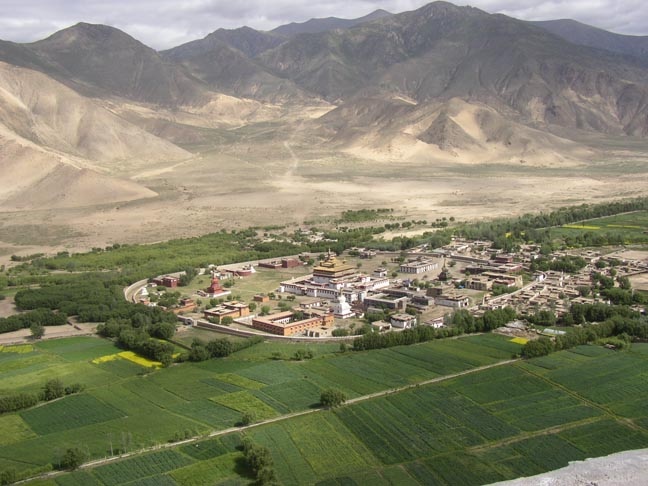 Today the group traveled by bus down the south side of the Yarlung Tsangpo,
crossed a bridge, and went farther up the Yarlung Tsangpo on its north
bank - to Samye Monastery. First they climbed Hepo Ri, a hill east of
the monastery, to look down on the monastery and adjacent village. They
are built on the floodplain of the Samye, valley a tributary to the Yarlung
Tsangpo, and are surrounded by trees. After lunch, they toured the monastery,
Tibet's oldest, having been founded between 765 and 780AD. Shaped like
a
Today the group traveled by bus down the south side of the Yarlung Tsangpo,
crossed a bridge, and went farther up the Yarlung Tsangpo on its north
bank - to Samye Monastery. First they climbed Hepo Ri, a hill east of
the monastery, to look down on the monastery and adjacent village. They
are built on the floodplain of the Samye, valley a tributary to the Yarlung
Tsangpo, and are surrounded by trees. After lunch, they toured the monastery,
Tibet's oldest, having been founded between 765 and 780AD. Shaped like
a  mandala, it has been damaged and destroyed many times in 1200+ years.
mandala, it has been damaged and destroyed many times in 1200+ years.
After dinner I gave a short thank you to the guides and students. Taylor
(guitar) and Miles sang a funny song they composed about Tibet and geology.
Tyler played guitar and sang his song about the future of a Tibetan boy.
Palden gave to Bob and Clare a small painting of the Buddha of Compassion,
and to Whitman College a large wall hanging of the same Buddha.
Later the students were singing and talking in the garden. They were joined
by English-speaking:
Consul
General from Saudi Arabia to China
Consul General from United Arab Emirates to China
Second Secretary Consular Dept., Ministry of Foreign Affairs, Peoples
Republic of China
They had long political
discussions as the UAR Consul General bought beer for all.
June
17: Leaving the Roof of the World (Lhasa - Bangkok)
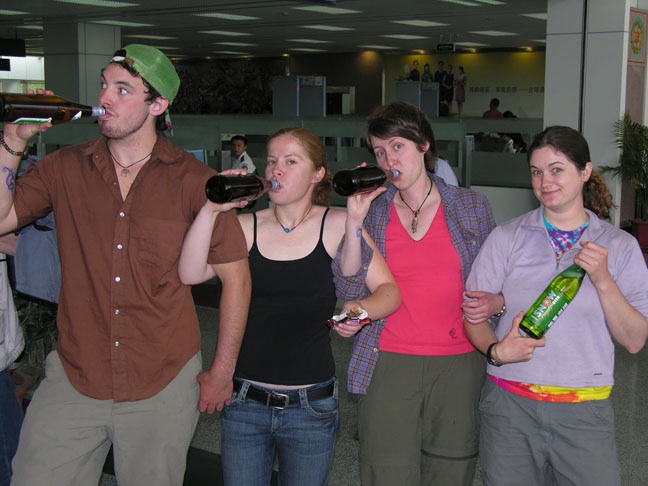 Today we leave Tibet; we go from high and dry to low and moist. We arose
early, and drove west along the south shore of the Yarlung Tsangpo.
I never tire of seeing the spectacular climbing dunes. At the airport
we had to say goodbye to our three dear guides, with hugs and some tears.
Today we leave Tibet; we go from high and dry to low and moist. We arose
early, and drove west along the south shore of the Yarlung Tsangpo.
I never tire of seeing the spectacular climbing dunes. At the airport
we had to say goodbye to our three dear guides, with hugs and some tears.
Security confiscated Taylor's Swiss Army knife, then used it to open
the Lhasa beers the students had. The students had to return
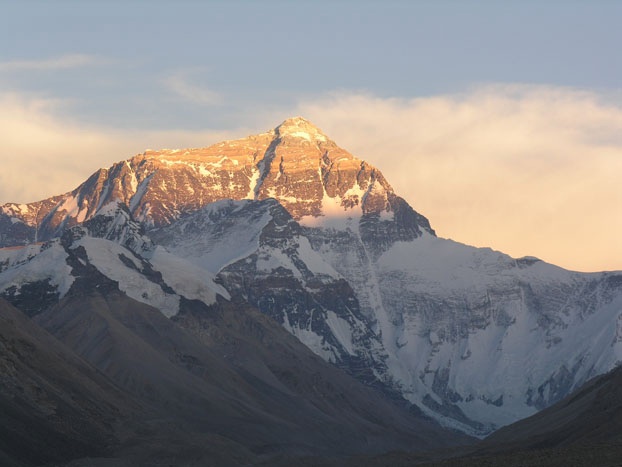 the beer bottles, full or empty, before they could have their boarding passes.
So, of course, the students drank the beers.
the beer bottles, full or empty, before they could have their boarding passes.
So, of course, the students drank the beers.
The flight to Chengdu in western China departed about 11am. Clouds prevented
our viewing the Himalayas we have come to love. |